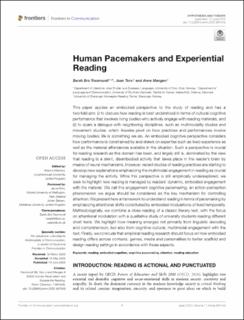| dc.contributor.author | Trasmundi, Sarah Bro | |
| dc.contributor.author | Toro, Juan | |
| dc.contributor.author | Mangen, Anne | |
| dc.date.accessioned | 2023-01-05T11:39:37Z | |
| dc.date.available | 2023-01-05T11:39:37Z | |
| dc.date.created | 2022-09-29T13:12:24Z | |
| dc.date.issued | 2022 | |
| dc.identifier.citation | Trasmundi, S. B., Toro, J., & Mangen, A. (2022). Human Pacemakers and Experiential Reading. Frontiers in Communication, 7. | en_US |
| dc.identifier.issn | 2297-900X | |
| dc.identifier.uri | https://hdl.handle.net/11250/3041187 | |
| dc.description.abstract | This paper applies an embodied perspective to the study of reading and has a two-fold aim: (i) to discuss how reading is best understood in terms of cultural-cognitive performance that involves living bodies who actively engage with reading materials, and (ii) to spark a dialogue with neighboring disciplines, such as multimodality studies and movement studies, which likewise pivot on how practices and performances involve moving bodies: life is something we do. An embodied cognitive perspective considers how performance is constrained by and draws on expertise such as lived experience as well as the material affordances available in the situation. Such a perspective is crucial for reading research as this domain has been, and largely still is, dominated by the view that reading is a silent, disembodied activity that takes place in the reader's brain by means of neural mechanisms. However, recent studies of reading practices are starting to develop new explanations emphasizing the multimodal engagement in reading as crucial for managing the activity. While this perspective is still empirically underexplored, we seek to highlight how reading is managed by readers' dynamic, embodied engagement with the material. We call this engagement cognitive pacemaking, an action-perception phenomenon we argue should be considered as the key mechanism for controlling attention. We present here a framework to understand reading in terms of pacemaking by emphasizing attentional shifts constituted by embodied modulations of lived temporality. Methodologically, we combine a close reading of a classic literary text, with the focus on attentional modulation with a qualitative study of university students reading different short texts. We highlight how meaning emerges not primarily from linguistic decoding and comprehension, but also from cognitive-cultural, multimodal engagement with the text. Finally, we conclude that empirical reading research should focus on how embodied reading differs across contexts, genres, media and personalities to better scaffold and design reading settings in accordance with those aspects. | en_US |
| dc.language.iso | eng | en_US |
| dc.publisher | Frontiers | en_US |
| dc.rights | Navngivelse 4.0 Internasjonal | * |
| dc.rights.uri | http://creativecommons.org/licenses/by/4.0/deed.no | * |
| dc.title | Human Pacemakers and Experiential Reading | en_US |
| dc.title.alternative | Human Pacemakers and Experiential Reading | en_US |
| dc.type | Peer reviewed | en_US |
| dc.type | Journal article | en_US |
| dc.description.version | publishedVersion | en_US |
| dc.rights.holder | The author | en_US |
| dc.subject.nsi | VDP::Samfunnsvitenskap: 200 | en_US |
| dc.source.volume | 7 | en_US |
| dc.source.journal | Frontiers in Communication | en_US |
| dc.identifier.doi | 10.3389/fcomm.2022.897043 | |
| dc.identifier.cristin | 2056817 | |
| cristin.ispublished | true | |
| cristin.fulltext | original | |
| cristin.qualitycode | 1 | |

